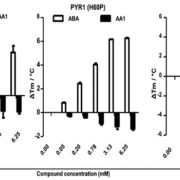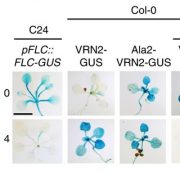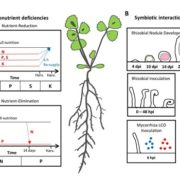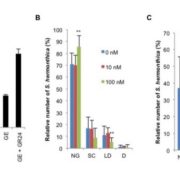CIRCADIAN CLOCK ASSOICATED 1 (CCA1) and the circadian control of stomatal aperture
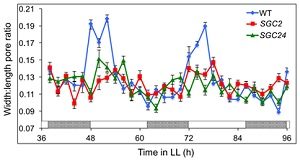 How do plants ‘decide’ how to respond to so many conflicting stimuli? What has the final say in stomatal aperture control? Hassidium et al. investigate the role of the oscillator gene CIRCADIAN CLOCK ASSOICATED 1 (CCA1) during stomatal opening and determined if CCA1 is responsive to other stimuli. Overexpression of CCA1 specifically in guard cells (SGC plants) results in higher CCA1 levels that are arrhythmic in nature and display impaired opening and closing in response to light. However, SGC guard cells responded normally to opening buffer and ABA. By analyzing expression levels of photoperiod pathway genes, the authors found an overlap between the FLOWERING LOCUS T (FT) and CCA1 pathway to regulate guard cell apertures. SGC plants showed decreased levels of FT, which was previously shown to positively regulate stomatal opening. Lastly, differences between WT guard cell dynamics grown in long day versus short day were observed: short day plants had lower FT levels and impaired stomatal dynamics. These data indicate that the circadian clock in concert with the photoperiod pathway is involved in regulating stomatal apertures. Understanding the mechanism of how different stimuli control stomatal dynamics will not only further our understanding of stomatal dynamics but also how plants respond to varying external and internal stimuli. (Summary by Alecia Biel) Plant Phys. 10.1104/pp.17.01214.
How do plants ‘decide’ how to respond to so many conflicting stimuli? What has the final say in stomatal aperture control? Hassidium et al. investigate the role of the oscillator gene CIRCADIAN CLOCK ASSOICATED 1 (CCA1) during stomatal opening and determined if CCA1 is responsive to other stimuli. Overexpression of CCA1 specifically in guard cells (SGC plants) results in higher CCA1 levels that are arrhythmic in nature and display impaired opening and closing in response to light. However, SGC guard cells responded normally to opening buffer and ABA. By analyzing expression levels of photoperiod pathway genes, the authors found an overlap between the FLOWERING LOCUS T (FT) and CCA1 pathway to regulate guard cell apertures. SGC plants showed decreased levels of FT, which was previously shown to positively regulate stomatal opening. Lastly, differences between WT guard cell dynamics grown in long day versus short day were observed: short day plants had lower FT levels and impaired stomatal dynamics. These data indicate that the circadian clock in concert with the photoperiod pathway is involved in regulating stomatal apertures. Understanding the mechanism of how different stimuli control stomatal dynamics will not only further our understanding of stomatal dynamics but also how plants respond to varying external and internal stimuli. (Summary by Alecia Biel) Plant Phys. 10.1104/pp.17.01214.


